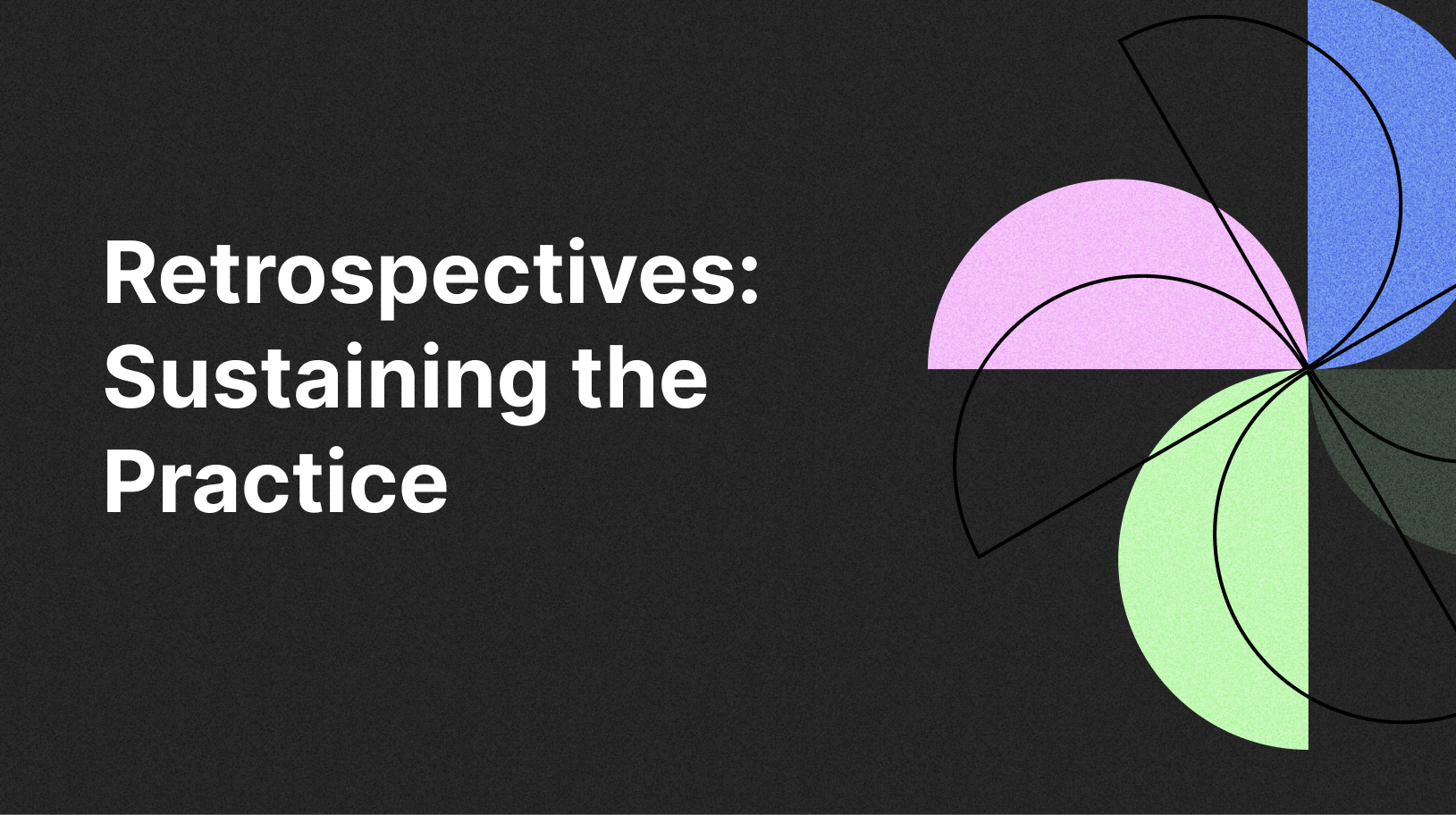Retrospectives: Sustaining the Practice
Nov 28, 2022
Sean Beckett

How often should groups run a Retro?
You should probably have a retrospective to correspond with each recurring planning meeting. If you have two-week sprints, have a retro every two weeks towards the end of the sprint. You should also hold a retro at the end of any off-site or all-day meeting. The retro should focus on those particular events and how they did or did not serve the participants. This way you can get direct and immediate feedback about the successes and areas for improvement for the next event.
If your retros always end with undiscussed topics on the board, consider lengthening the meeting or holding it more often. It may also be helpful to reduce the number of people in the retro.
If the board is consistently too empty to fill the scheduled time, consider reducing the frequency or duration of the retro meetings.
When to schedule them
Retrospectives are most productive when the team feels safe and secure in committing to the meeting. The later in the day and the later in the week, the better. Early in our day or in the week, we have many pending concerns and need to reserve some energy and attention for unexpected challenges. By late afternoon, the day’s challenges are mostly handled or deferred, and by Thursday or Friday, the same is true of the week’s challenges.
Retros should start at 55 minutes by default. Retros shouldn’t run longer than 90 minutes, as the intensity of collaborative, radically honest conversation is too high to maintain for longer than that. Some folks might be able to keep going, but other members of the team will undoubtedly stop contributing. Shorter 25 minute sessions may be appropriate for multi-team retros where each participating team has their own recurring retro as well.
Retros with Remote teams
As with any recurring ritual, accommodating the reality of geographically disparate teams is important, challenging, and situationally specific. In general, using an all-remote approach is best. If everyone cannot be in the same room, everyone should be in the same video collaboration tool by themselves. A meeting with some people physically in a conference room and others in a teleconference inevitably favors those in the room and leads to feelings of disconnection or inequity for the others.
Everyone should have video on for the entire meeting to create a feeling of connection and attention. Facilitation requires more direct monitoring of eye contact and engagement, since the lure of external devices or distractions is even stronger when we are not physically colocated. Don’t be afraid to call out people whose eyes are no longer watching the conversation or who haven’t contributed in a while.
Using asynchronous collaboration tools to record retro topics and Action Items goes a long way towards building cohesion with a remote group. Everyone sees the same source of truth and can interact with it in their own context and on their normal schedule. Shared spreadsheets or whiteboards are excellent for this use case, and everyone should have full edit rights.
Time zone diversity can make scheduling challenging for distributed teams. No one wants to attend a retro outside of their usual working hours, but there may not be a single time where everyone is available by default. Start with a set schedule but regularly collect feedback and agree to iterate on the timing. Often this can mean varying the retro schedule periodically so that everyone has some meetings at their ideal time and some meetings at not so ideal times, but no one person or location has all ideal or all non-ideal meeting times.
How to stay accountable
As we described in the Action Items and After the Meeting sections, it is imperative that Action Items and Owners are recorded somewhere public to the team and reviewed on a periodic basis. Team leads and stakeholders should feel accountable to build a process where the Action Items are relevant and not considered a “distraction from the real work”. Putting the Action Items into the normal project or story planning flow is an excellent way to make them first class tasks alongside everything else we do as a team. This emphasis also reinforces the importance and value of retrospectives, and drives deeper engagement and better results.
Handling Anti-Patterns
We always strive for high team participation, radical candor with empathy and kindness, and strong personal and collective accountability. That doesn’t always happen, of course, and when things aren’t feeling right here are some things to try.
Psychological safety is a necessary prerequisite for productive retros. Be mindful of how much mutual trust and confidence exists in your retro teams.
Someone celebrates but most don’t agree
If some are celebrating an accomplishment that group doesn’t fully agree with, that indicates a mismatch in the understanding of the task and the goals. Perhaps there’s more to the task and the celebration is premature, or the benefits only help a few folks. If the group isn’t happy for the people receiving the benefits, that might indicate some resentment or feelings of favoritism or exclusion. It’s worth finding out if the group thinks the celebration is too early, or is not warranted at all. The celebrant may be someone with more enthusiasm or optimism about future outcomes. Perhaps the team can learn more optimism, or perhaps the enthusiast is too quick to ignore downsides.
Everyone celebrates but a few don’t agree
If the group is celebrating an accomplishment or a result but some don’t agree, that may be exposing feelings of exclusion or favoritism. Generally we are happy for our peers when good things happen to them, so when folks aren’t happy, it is worth understanding why. Explore with the holdouts why they don’t think the result is worth celebrating. Is it too early to count as a win, or is it a win with significant downsides, or are they maybe feeling left out of the benefits? This may be better discussed one on one, so an action item can be to follow up with the folks who aren’t as keen on the celebration and discover their reasons for reluctance.
Someone complains but most don’t agree
Teams are not always in agreement but in general they know when something is painful, even if that pain is not universally experienced. If one or a few folks in the retro are unhappy and the team doesn’t seem to agree or understand, it is important to find out why and restore a general agreement among the team. It might be that some of the team are significantly more burned out, or have lost faith that hard work and time will fix the issue. It might be that some on the team are just having a hard week or a rough time personally and it’s bleeding into retro opinions. It could be that the team has happily concentrated the frustrating or hard parts of the work onto a few disempowered individuals. It’s hard to say what is leading to this mis-match, but this is one of the most important signals to track down. Talk to affected people after retro, talk to their people managers, and make sure that the team rebuilds understanding for the frustrations currently felt by only a few.
Everyone complains but a few don’t agree
This one is an unlikely occurrence, where most of the team is feeling some pain or frustration but a few individuals don’t agree. It might be that a few people on the team are shielded from the pain, or it could be that some members of the team have more agency and thus feel less trapped in the frustrations. The goal is likely to build empathy for the team’s frustrations with the few people that don’t share it. Folks don’t need to feel bad but they should understand why others on the team are saying there’s an area for improvement.
People only raise “safe” topics and avoid meaningful criticism
Expressing our fears makes us vulnerable and may open us up to ridicule or retaliation by the group or leaders. It is imperative that people are empowered to speak and see meaningful change for doing so, and that no one is punished for speaking truth to power, or for having a different response than the rest of the group.
Someone rarely participates
Ideally, everyone should speak every retro, even if it’s just one celebratory topic. Encourage everyone to add at least one item to the retro board, and that should lead to them being asked by the facilitator to explain the item when the group is ready to discuss it. If folks are quiet during retros, it might indicate a lack of trust that their views will be heard and respected or a lack of faith that speaking up will have any positive impact. It may even indicate they fear retribution for sharing an unpopular opinion. It could also be that retros take place during a time when the person is tired or disconnected, and varying the retro schedule might help. Talking with them privately between retros will give you more insight as to what’s blocking or limiting their participation.
Everyone rarely participates
If no one is energetic or engaged with retros, this probably indicates a fundamental challenge. It could be something simple, like the retro meeting is happening at a time not conducive to honest participation. Retrospection is an emotional activity and requires some reserves of trust and enthusiasm that are more possible in some situations.
If folks don’t feel safe being honest, retrospectives can’t function very well. This could indicate a larger team challenge where psychological safety needs to be established. It is a necessary prerequisite for healthy retros. If folks can’t be candid about past efforts, progress is very difficult.
If the facilitator is somehow intimidating or off-putting to the team, people will be reluctant to speak up. While retros can easily be run by most team members, when getting them going with new teams or with many people new to retros, it is important to use an experienced facilitator.
Some retros may also be sparse because there isn’t much happening to which to react. Retros between teams with only occasional collaboration might not have enough ongoing topics to generate discussions for more than a few minutes.
People are distracted or multi-tasking
For first offenses, it is important to acknowledge the challenge of focus in our hyper-connected world. Encourage people to leave phones and laptops at their desks when coming to the meeting, and for all-remote retros encourage people to turn off notifications and keep their hands off the keyboard as much as possible. When someone is having trouble during a meeting, a discrete word in their ear or via direct message can help restore their focus to the team.
For the next few instances of distraction, it’s powerful to call them out during the meeting. Peer pressure is very powerful and few people enjoy being singled out for repeated transgressions.
If someone is consistently distracted or multi-tasking, it might be necessary to remove them from the retro for a while. The retro will function just as well in their absence, and perhaps they didn’t need to be part of it. If they do miss being part of the retro, they will be more likely to follow the meeting guidelines after learning the cost of not participating.
Alternate formats
Retrospectives have hundreds of variations, some of which may be more appropriate depending on a number of factors. Some formats are better to run with multiple teams; in response to specific events; between clients and consultants; with a large spread of hierarchical power in the room; or when topics are known to be controversial or highly emotional. A simple search for “retrospective formats” will turn up an endless list of blog posts, and many collaboration tools have multiple retro templates available to select.
There is no one answer, except that any retro format is better than no retro at all. Keep experimenting until one resonates with the team, and be open to feedback. The key to an iterative process is that each iteration should try something a little different so we can learn something new.


